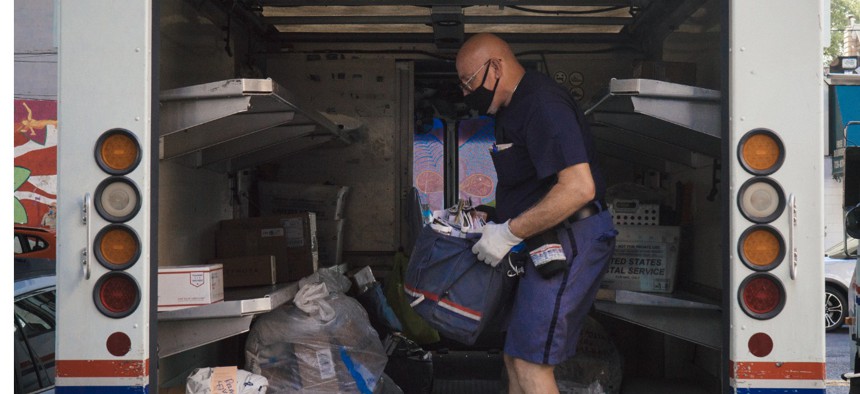
The Postal Service previously announced voluntary early retirement The Postal Service previously announced voluntary early retirement incentives for eligible workers. Massimo Giachetti / istock
Postal Service to Issue Layoff Notices Later This Month
USPS declined to specify how many positions would be eliminated, but said it aims to offer impacted workers opportunities for reassignment.
Some U.S. Postal Service employees will receive layoff notifications later this month, the mailing agency told workers in a memorandum this week.
The announcement comes as part of a restructuring plan put in place by Postmaster General Louis DeJoy, who is targeting non-union management and administrative staff for the so-called reductions in force, or RIFs. The Postal Service previously announced voluntary early retirement incentives for eligible members of that contingent of its workforce, noting it was part of a procedure to avoid layoffs. USPS will offer a second round of the incentive to employees before the RIFs take effect, again without any buyout component. Government Executive first reported in April that layoffs appeared likely.
The Postal Service has about 60,000 employees in its headquarters, area and district offices that make up the population targeted for reductions, but the agency declined to specify the number of positions it will eliminate. The RIFs will be the third phase of DeJoy’s reorganization, following a realignment of postal work into three divisions last summer and the consolidation of USPS’ 67 districts into 50, announced earlier this year.
“As a result of a reduction in the number or elimination of authorized positions due to the organization change, there will be a RIF in the affected competitive areas,” USPS Chief Human Capital Officer Doug Tuling wrote in the memo.
National Association of Postal Supervisors President Brian Wagner last month commended postal management for working closely with his organization throughout the process and said he expected affected employees would likely have an opportunity to take a reassignment to avoid a layoff. USPS has operated under a hiring and promotion freeze among supervisory and administrative positions throughout headquarters and district offices since August, leaving vacancies that laid off staffers could transfer into if they chose to do so.
Tulino noted the hiring freeze ended on Monday to allow for placements of impacted workers. Those positions will be posted starting later this month, including one group of openings specifically for impacted employees. The roles will include other openings at the headquarters, area and district levels, as well as some customer service and plant positions.
Those who do not accept a new position will have to leave the Postal Service by Oct. 8, while those who take new jobs will have to start them by Oct. 9. Impacted employees will receive their RIF notices on May 21.
Dave Partenheimer, a USPS spokesman, said the changes would ensure all USPS support functions are centralized at the agency’s Washington headquarters. He said the second voluntary early retirement offer would create more openings that laid off workers could potentially fill, allowing for "minimal disruption to the workforce."
Postal management recently told employees it would not lay employees off as part of its new round of facility consolidations, though a spokesperson made clear that promise applied specifically to just that action. The Postal Service has dramatically cut its career workforce since its peak around the turn of the millennium, but has frequently boasted it relied on natural and incentivized attrition—rather than involuntary layoffs—to do so. In 2015, however, the Postal Service hired a “RIF administrator.”
While USPS has long sought to avoid layoffs, DeJoy also sought to downplay that his approach was anything out of the ordinary.
The plan will “reduce the size of our administrative organization, which is not uncommon when we go through big, big reorganizations and reestablishment of what you’re going to be doing in the future,” the postmaster general said in March.







